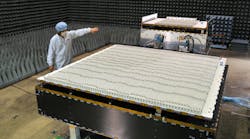Precipitation Radar Employs Variable Pulse Repetition
During space missions, long-range observation often causes delays between receiving and transmitting signals. But efficient sampling can be achieved by transmitting pulses successively. This method of variable pulse repetition frequency (VPRF) is currently being utilized by the dual-frequency precipitation radar (DPR) aboard the Global Precipitation Measurement (GPM) Core Observatory satellite. That mission seeks to better understand the Earth’s weather and climate cycles by more accurately measuring precipitation.
The DPR was developed by the Japan Aerospace Exploration Agency (JAXA) and National Institute of Information and Communication Technology in Tokyo. Using emitted radar pulses, it makes detailed measurements of rainfall’s three-dimensional structure and intensity. This approach allows researchers to improve estimates of how much water the precipitation holds.
The instrument consists of two radars: a Ka-band precipitation radar (KaPR) at 35.5 GHz and a Ku-band precipitation radar (KuPR) at 13 GHz. The KaPR detects snow and light rain while the KuPR detects heavy rain. Combined, the DPR has 190-kb/s bandwidth over the 1553B spacecraft data bus.
The instrument has a vertical range resolution of 250 m, which provides vertical information at scales needed to resolve cloud structures. Both channels scan the beams in the cross-track direction to broaden observation areas. This effort is aided by the VPRF technique (see figure), which increases the number of samples at each instantaneous field of view (IFOV) and realizes 0.2 mm/h sensitivity. Such sensitivity allows for insight into the microphysical processes—evaporation, collision/coalescence, aggregation—that helps to distinguish regions of precipitation.
The satellite also houses a global microwave imager (GMI) that uses highly sensitive frequencies to discriminate between the noise and signatures of small particles of precipitation (see “Precipitation Microwave Imager Flexes Its Frequency Range” on Microwaves & RF). Together, the instruments provide a three-dimensional view of the column of precipitation. The Core Observatory satellite was successfully launched from Tanegashima Space Center, Japan in February 2014.

